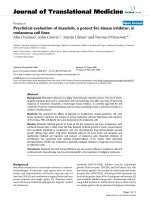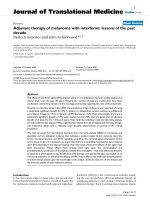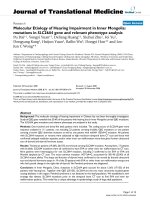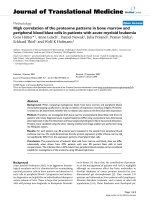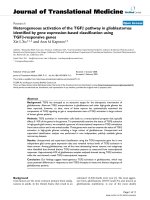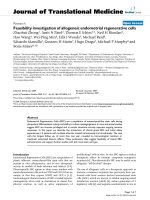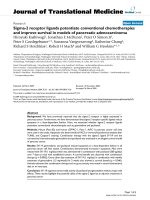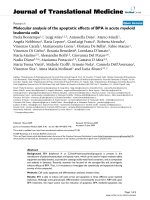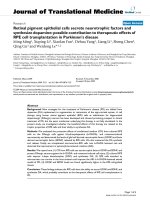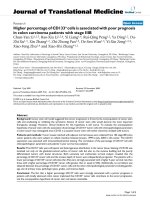Báo cáo hóa học: " Computer simulations of neural mechanisms explaining upper and lower limb excitatory neural coupling Huang and Ferris" docx
Bạn đang xem bản rút gọn của tài liệu. Xem và tải ngay bản đầy đủ của tài liệu tại đây (1.18 MB, 13 trang )
JNER
JOURNAL OF NEUROENGINEERING
AND REHABILITATION
Computer simulations of neural mechanisms
explaining upper and lower limb excitatory
neural coupling
Huang and Ferris
Huang and Ferris Journal of NeuroEngineering and Rehabilitation 2010, 7:59
(10 December 2010)
RESEA R C H Open Access
Computer simulations of neural mechanisms
explaining upper and lower limb excitatory
neural coupling
Helen J Huang
1*
, Daniel P Ferris
1,2,3
Abstract
Background: When humans perform rhythmic upper and lower limb locomotor-like movements, there is an
excitatory effect of upper limb exertion on lower limb muscle recruitment. To investigate potential neural
mechanisms for this behavioral observation, we developed computer simulations modeling interlimb neural
pathways among central pattern generators. We hypothesized that enhancement of muscle recruitment from
interlimb spinal mechanisms was not sufficient to explain muscle enhancement levels observed in experimental
data.
Methods: We used Matsuoka oscillators for the central pattern generators (CPG) and determined para meters that
enhanced amplitudes of rhythmic steady state bursts. Potential mechanisms for output enhancement were
excitatory and inhibitory sensory feedback gains, excitatory and inhibitory interlimb coupling gains, and coupling
geometry. We first simulated the simplest case, a single CPG, and then expanded the model to have two CPGs
and lastly four CPGs. In the two and four CPG models, the lower limb CPGs did not receive supraspinal input such
that the only mechanisms available for enhancing output were interlimb coupling gains and sensory feedback
gains.
Results: In a two-CPG model with inhibitory sensory feedback gains, only excitatory gains of ipsilateral flexor-
extensor/extensor-flexor coupling produced reciprocal upper-lower limb bursts and enhan ced output up to 26%.
In a two-CPG model with excitatory sensory feedback gains, excitatory gains of contralateral flexor-flexor/extensor-
extensor coupling produced reciprocal upper-lower limb bursts and enhanced output up to 100%. However, within
a given excitatory sensory feedback gain, enhancement due to excitatory interlimb gains could only reach levels
up to 20%. Interconnect ing four CPGs to have ipsilateral flexor-extensor/extensor-flexor coupling, contralateral
flexor-flexor/extensor -extensor coupling, and bilateral flexor-extensor/extensor-flexor coupling could enhance motor
output up to 32%. Enhancement observed in experimental data exceeded 32%. Enhancement within this
symmetrical four-CPG neural architecture was more sensitive to relatively small interlimb cou pling gains. Excitatory
sensory feedback gains could produce greater output amplitudes, but larger gains were required for entrainment
compared to inhibitory sensory feedback gains.
Conclusions: Based on these simulations, symmetrical interlimb coupling can account for much, but not all of the
excitatory neural coupling between upper and lower limbs during rhythmic locomotor-like movements.
Background
Central pattern generators (CPGs) are spinal neural net-
works that produce rhythmic motor commands. For
vertebrate locomotion, they are theorized to consist of
two half-centers with reciprocal inhibition [1]. W hen
one half-cente r is active, the oth er half is inh ibited, pro-
ducing alternating rhythmic bursts. Key features of cen-
tral pattern generators are that they can produce
rhythmic outputs without rhythmic inputs and they can
entrain their rhythmic outputs to sensory feedback.
Experimental data on both anim als and in humans
* Correspondence:
1
Department of Biomedical Engineering, Human Neuromechanics
Laboratory, University of Michigan, 401 Washtenaw Ave., Ann Arbor, MI,
48109-2214, USA
Full list of author information is available at the end of the article
Huang and Ferris Journal of NeuroEngineering and Rehabilitation 2010, 7:59
/>JNER
JOURNAL OF NEUROENGINEERING
AND REHABILITATION
© 2010 Huang and Ferris; licensee BioMed Central Ltd. This is an Open Access articl e distributed under the terms of the Creative
Commons Attribution License ( which permits unrestricted use, distribution, and
reproduction in any medium, provided the original work is properly cited.
support the idea that central pattern generators exist. A
spinalized cat can be taught to walk after repeated step
training [2,3]. In humans, individuals with incomplete
and even clinically complete spinal cord injuries can
produce rhythmic lower limb motor patterns with
appropriate sensory feedback [4-8].
Central pattern generato rs can be modeled with non-
linear mathematical equations that produce an oscilla-
tory output. The Matsuoka oscillator is one type of
mathematical oscillator that has been used to simulate
biological oscillators [9-17]. The Matsuoka oscillator
consists of two reciprocally inhibited simulated neurons
[9,10], similar to the half-center theory of biological cen-
tral pattern generators [1]. Each neuron receiv es a tonic
input, which corresponds to the tonic descending signal
from the midbrain that drives rhythmic output in bi olo-
gical loco motor neural netwo rks [18,19]. Matsuoka
oscillators have been applied to simulate neuromechani-
cal control of bio-inspired robots [13-15] and computer
models of biomechanical bodies [16,17,20]. Previous
modeling studies inter-connecting neural oscillators
have investigated coupling effects on frequency, ph asing,
synchronization, and coordination of o scillator outputs
[21]. However, we are unaware of any models of inter-
connected neural oscillators that focus on changes in
oscillator amplitude.
We are interested in understanding the role of inter-
oscillator connections on oscillator output because it
may provi de greater insight abo ut int erlimb neura l cou-
pling observed in humans. Experiments on humans have
shown that upper limb movement and muscle recruit-
ment can alter lower limb muscle activation [22,23].
Specifically, greater upper limb effort increases muscle
activation of passive lower limbs in neurological ly i ntact
individuals [24-26] and individuals with incomplete
spinal cord injuries [27] during a rhythmic upper and
lower limb movement task. Conversely, active lower
limb effort also increases passive upper limb muscle
activation [25,27]. Upper limb movement can also alter
lower limb muscle activation patterns in individuals
with incomplete spinal cord injuries during a standing
reciprocal leg swing task [28] and in individuals with
stroke during treadmill training [29]. Addit ionall y, clin i-
cal observations suggest that reciprocal arm swing
increases and improves muscle activation in individuals
with spinal cord injuries [8,30]. The neural mechanisms
responsible for these interlimb excitatory effects are dif-
ficult to determine in humans.
One approach for investigating the neural mechanisms
involved in the experimental observations is to model
the neural pathways. The purpose of this computer
simulation study was to test potential neural mechan-
isms that may explain excitatory interlimb coupling in
humans. We hypothesized that interlimb spinal
pathways could not account for the levels of muscle
recruitment enhancement revealed in our previous
experimental studies [25]. Believing in the principle that
the simplest model that can explain an observed beha-
vior provides key insight into the dynamics [31], we
aimed to create the simplest model possible that still
faithfully reproduced the most important behavioral
observations from our previ ous studies. We used a Ma t-
suoka oscillator to model the central pattern generator
for each limb. To understand the effects of interlimb
coupling on output enhancement, we used a systematic
approach, beginning with a single CPG model, then a
two-CPG model, and lastly a four-CPG model. We first
determined behavioral principles associated with
increasing sensory feedback gains and frequencies for
enhancing CPG output in a single CPG. We then tested
a two-CPG model to determine the effect of coupling
flexors to flexors and extensors to extensors (flexor-
flexor/extensor-extensor) versus crossing the connec-
tions to couple flexors with extensors (flexor-extensor/
extensor-flexor). Lastly, we interconnected four Mat-
suoka oscillators to test the effects of different combina-
tions of inhibitory and/or excitatory interlimb pathways.
Methods
Matsuoka oscillators
We modeled each limb’s central pattern generato r using
a Matsuoka oscillator (Figure 1) with the following gov-
erning equations:
1
1
xcx v x hg
if i if if ie j j
j
n
,,,,
=− − −
⎡
⎣
⎤
⎦
−
⎡
⎣
⎤
⎦
+
=
+
∑
(1)
f
e
Flexor
Neuron / Muscle
Output
Extensor
Neuron / Muscle
Output
Reciprocol
Inhibition
Self
Inhibition
Self
Inhibition
Ʉሾ
f
]
+
Ʉሾ
e
]
+
ሾ
e
]
+
= y
e
ሾ
f
]
+
= y
f
ȭ
i
ሾ
i
]
+
ȭ
i
ሾ
i
]
-
Ⱦ
f
Ⱦ
e
Tonic
Descending
Input
External
Inputs
(
i.e. Sensory
Feedback,
Outputs of
other
Oscillators
)
Oscillator
Output
y
out
= y
f
- y
e
Figure 1 Schematic of a Matsuoka oscillator . Two neurons, a
flexor (f) and an extensor (e), reciprocally inhibit each other. External
inputs (g
i
) such as sensory feedback or inputs for other neurons can
be either inhibitory or excitatory, depending on the gain ( h
i
). Black
circles indicate inhibitory inputs. White circles indicate excitatory
inputs. Gray circles can be either inhibitory or excitatory.
Huang and Ferris Journal of NeuroEngineering and Rehabilitation 2010, 7:59
/>Page 3 of 13
2
vvx
if if if,,,
=− +
⎡
⎣
⎤
⎦
+
(2)
1
1
xcx v x hg
ie i ie ie if j j
j
n
,,,,
=− − −
⎡
⎣
⎤
⎦
−
⎡
⎣
⎤
⎦
+
=
−
∑
(3)
2
vvx
ie ie ie,,,
=− +
⎡
⎣
⎤
⎦
+
(4)
yx
if if,,
=
⎡
⎣
⎤
⎦
+
(5)
yx
ie ie,,
=
⎡
⎣
⎤
⎦
+
(6)
Each flexor (f) and extensor (e) neuron has a firing rate, x
i
and an adaptation state, υ
i
where i = RU (Right Upper
Limb), LU (Left Upper Limb), RL (Right Lower Limb), and
LL (Left Lower Limb). The output of the flexor or extensor
neuron is y
i,f
or y
i,e
and is equal to [x
i
]
+
the positive part of
the flexor or extensor neuron firing rate x
i
, respectively.
Similarly, [g
j
]
+
is the positive part of the external input and
[g
j
]
-
is the negative part of the external input. Each external
input has an associated gain, h
j
. Possible external inputs
include joint angle, limb angle, neuron activity, among
others. In the Matsuoka oscillator equations, positive gains
provide inhibitory feedback while negative gains provide
excitatory feedback. We focused on inhibitory sensory feed-
back which appears to more faithfully reproduce biological
systems. The constant c
i
is the t onic descending signal,
which represents descending neural drive from the mid-
brain [ 18,19]. The b constant modulates the strength of
self-inhibition and the h constant modulates the strength of
reciprocal inhibition between the flexor and extensor neu-
rons. τ
1
and τ
2
are time constants that affect the shape and
intrinsic frequency of the oscillator.
The baseline parameter values our model were c =2,b =
2.5, h =2.5,τ
1
= 0.35, and τ
2
= 0.7, which we set according
to previously developed guidelines [14]. Tonic descending
input, c = 2 produces an oscillator output amplitude of ~1,
which made it easier to compare output amplitudes. We
set τ
1
and τ
2
to provide an endogenous oscillator frequency
of 0.32 Hz, ω
cpg
, which is slower than normal walking step
frequencies. For the sensory feedback signal which was
analogous to joint angle, we used a sine wave with a fre-
quency of 0.625 Hz, ω
s
, and amplitude of 1. This fre-
quency matched the stepping frequencies we used in our
recumbent stepping experimental studies [24,25].
One-CPG model
Using a single Matsuoka oscillator, we determined the
effects of increasing sensory feedback strength and
frequency on enhancing oscillator output for a given tonic
descending signal, c = 2. We set the sensory feedback gain
to be h
s
=k
s
*c, which was relative to the tonic descending
drive input. Similarly, we set the sensory feedback fre-
quency to be ω
s
=k
ωs
*ω
cpg,
which was relative to the
endogenous fr equency of the oscillator. Oscillator ampli-
tude enhancement occurred if parameters led to greater
oscillator output amplitudes compared to the baseline
condition of no sensory feedback, h
s
=0orω
s
=0.
Two-CPG models
In a two-CPG model, there were two po ssible coupling
geometries: A) c onnecting the flexor neurons to each
other and the extensor neurons to each other (f-f/e-e)
and B) connecting the flexor neuron to the extensor neu-
ron of the other oscillator (f-e/e-f). These models repre-
sented interlimb coupling pathways between an upper
limb CPG and a l ower limb CPG. To simulate ipsilateral
coupling, h
ip
, we set the lower limb CPG sensory feed-
back, h
slo
=sin(2πω
s
t+π)tobeanti-phasewiththe
upper limb CPG sensory feedback, h
sup
=sin(2πω
s
t),
simulating the anti-phase movement of ipsilateral limbs
during locomotion. To simulate contralateral coupling,
h
c,
we set the sen sory feedback of the lower limb CPG to
be in-phase with the upper limb CPG, simulating phasing
of contralateral upper-lower limb pair during locomo-
tion. The lower lim b CPG received no to nic descending
drive, c
lo
= 0 while the upper limb CPG tonic des cending
drive was set to c
up
= 2. This tested whether interlimb
coupling, h
ip
or h
c
, could result in enhancement of the
lower limb CPG. We tested excitatory and inhibitory ipsi-
lateral h
ip
gains (or contralateral h
c
gains), in combina-
tion with either excitatory or inhib itory sensory feedback.
Thus, the parameters tested were coupling geometry (f-f/
e,e and f-e/e-f), coupling gain (h
ip
or h
c
), and lower limb
sensory feedback gain, h
slo
.
Four-CPG model
Experimental studies suggest that there is interlimb
neural coupling [22,32]. If the primary mechanisms of
interlimb neural coupling are spinal connections among
the locomotor networks, then interconnecting four Mat-
suoka oscillators would be a simple representative
model. One advantage of computer simulations is that
we can test different connection configurations or
neural architectures. In a previous experimental study,
we showed a preference for ipsilateral neural coupling
of flexors and extensors during a locomotor-like move-
ment [25] and predicted that this feature would be
inherent in a four-CPG model. We selected coupling
geometries based on our two-CPG model results and
explored a three dimensional parameter space consisting
of bilateral (h
b
) gains, contralateral (h
c
)gains,and
Huang and Ferris Journal of NeuroEngineering and Rehabilitation 2010, 7:59
/>Page 4 of 13
ipsilateral ( h
ip
) gains. We tested both excitatory and
inhibitory coupling gains. We also focused on symmetri-
cal coupling structures such that the gain was the same
in both directions (ex. from upper to lower and from
lower to upper CPGs). The upper limb CPG tonic des-
cending drive was set to c
up
= 2 and the lower limb
CPG tonic descending drive was set to c
lo
=0.The
lower limb sensory feedback was set to be inhibitory,
h
s_lo
=1.
Simulation and Analysis
We built the model in MATLAB software prog ram
(Mathworks, Natick, MA) and performed each s imula-
tion with a time step of 0.01 seconds for 20 seconds.
We considered oscillator out put to be analogou s to
muscle recruitment and calculated the output frequency
and peak amplitude for each oscillator output burst. We
defined the period of each burst as the time between
consecutive rising edges of output activity. From each
period, we calculated an output frequency. To determine
muscle recruitment amplitudes, we identified peak
values of the output bursts. Enhancement occurred
when amplitudes exceeded the amplitude of the baseline
condition. We rejected parameter sets that did not
demonstrate steady state, alternation of flexor and
extensor bursts within an oscillator, correct phasing
among oscillators, or entrainment to the sensory feed-
back frequency. We then compared lower limb CPG
enhancement p redicted from the m odels to experimen-
tal data t hat showe d enhanc ement of 50+% passive
lower limb muscle recruitment with maximal effort in
the upper limbs [24,25,27].
Results
In the one-CPG model, inhibitory sensory feedback
gains enhanced oscillator output up to 12% (Figure 2).
Enhancement occurred when output amplitude
exceeded 0.96, the baseline amplitude of the oscillator
with no sensory feedback k
s
=0ork
ωs
=0.Foragiven
inhibitory feedback gain (e.g. k
s
= 1), output amplitudes
decreased with increasing sensory feedback frequency.
For sensory feedback frequencies less than twice the
endogenous frequency, increasing inhibitory sensory
feedback gains initially enhanced output and then atte-
nuated output amplitude. For excitatory sensory feed-
back gains in the one-CPG model, increasing excitatory
feedback gains increased amplitude enhancement. For a
given excitatory feedback gain (e.g. h
s
= -1), maximal
enhancement occurred when the sensory feedback fre-
quency matched t he endogenous oscillator frequency,
k
ωs
=1orω
s
= ω
cpg
.
The two-CPG model with inhibitory sensory feedback
gains that p roduced rhythmic bursts in the lower limb
CPG that were out-of-phase with the upper limb CPG
bursts was the ipsilateral flexor-extensor/extensor-flexor
coupling model (Figure 3 *). This model enhanced lower
limb CPG amplitude up to 26%. We defined enhance-
ment as the lower limb CPG output divided by the base-
line amplitude of 0.96. This basel ine amplitude value
was the amplitude of the upper limb CPG output and
would have been the baseline amplitude of the lower
limb CPG if it were to receive the same descending
tonic input as the upper limb CPG. The two-CPG mod-
els with excitatory sensory feedback gains that pro duced
alternating rhythmic bursting pattern between the upper
and lower limb CPGs were the contralateral coupling
models (Figure 4 *). The contralateral flexor-flexor/
extensor-extensor model generated rhythmic steady
state bursting patterns in more of the contralateral gain-
sensory feedback gain parameter space than the contral-
ateral flexor-extensor/extensor-flexor model. In the
flexor-flexor/extensor-extensor contralateral coupling
model, excitatory contralateral gains enhanced lower
limb CPG output by up to 20% while in the flexor-
extensor/extensor-flexor contralateral coupling model,
excitatory contralater al gains enhanced lower limb CPG
output by up to 3%. Here, enhancement was defined
within a single excitatory sensory feedback gain such
that enhancement was due to changes in excitatory con-
tralateral gains, not due to excitatory sensory feedback.
Specifically, enhancement within a specific se nsory feed-
back gain equaled the difference between the maximum
amplitude observed across excitatory interlimb coupling
gains and the baseline amplitude when the interlimb
couplin g gain was zero. The maximal enhancement due
to excitatory interlimb coupling occurred at excitatory
sensory feedback h
s_lo
=-2(Figure4“ max” lab el). At
greater excitatory sensory feedba ck gains, h
s_lo
=-3and
-4, enhancement reached 16% and 13%, respectively.
Based on the two-CPG models, we interconnected
four CPGs to have ipsilater al flexor-extensor/extensor-
flexor coupling and contralateral flexor-flexor/extensor-
extensor coupling. We then added either bilateral
flexor-flexor/extensor-extensor coupling or bilateral
flexor-extensor/ex tensor-f lexor coupling. Both models
generated alternating flexor and extensor muscle bursts
of the upper left and lower right CPGs that were in-
phase (Figure 5). Likewise, the upper right and lower
left limb flexor and extensor bursts were also in-phase
with each other. The muscle recruitment patterns of the
upper left and lower right CPG pair were out-of-phase
with the burst patterns of t he upper right and lower left
CPG pair. The ipsilateral flexor-extensor/extensor-flexor,
contralateral flexor-flexor/extensor/ext ensor, and bilat-
eral flexor-extensor/extensor-flexor model enhanced
output up to 32% (Figure 5). Maximal enhancement
occurred with excitatory ipsilateral and contralateral
coupling gains and with inhibitory bilateral coupling.
Huang and Ferris Journal of NeuroEngineering and Rehabilitation 2010, 7:59
/>Page 5 of 13
Additionally, this four-CPG model required relatively
small interlimb coupling gains (Figure 5). In the i psilat-
eral flexor-extensor/extensor-flexor, contralateral flexor-
flexor/extensor-extensor, and bilateral flexor-flexor/
extensor-extensor four-CPG model, enhancement
reache d levels of up to 46% (Figure 6). However, unlike
the bilateral flexor-extensor/extensor-flexor four-CPG
model, maximal enhancement occurred with excitatory
bilateral coupling gains and at relatively larger bilateral
coupling gain values.
Discussion
These sim ulations indicated that interlimb coupling can
enhance rhythmic s teady state muscle recruitment pat-
terns during rhyth mic locomotor-like movements.
However, the enhancement due to interlimb coupling
was limited to < 32%. During a rhythmic locomotor-like
task, active reciprocal rhythmic arm exertion can
enhance passive lower limb muscle activity by > 32%
[24,25,27]. While inc reasing excitatory ipsilateral, con-
tralateral, and/or bilateral gains in the two-CPG and
four-CPG models could provide greater enhancement,
gains too large no longer produced rhythmi c alternating
bursts of the lower limb flexors and extensors. The
results from the models and experimental data sug-
gested that excitatory interlimb pathways alone were not
suffi cient to explain muscle enhancement of unintended
muscles.
Interlimb pathways that connect the upper and lower
limb locomotor n etworks likely significantly contribute
Frequency (Hz)Peak Amplitude
Excitatory Sensory Feedback Gain, k
s
Inhibitory Sensory Feedback Gain, k
s
Frequency (Hz)Peak Amplitude
3 ω
cpg
2 ω
cpg
1 ω
cpg
0.5 ω
cpg
0 ω
cpg
Sensory
Feedback
Frequency,
ω
s
Sensory Feedback
Frequency Gain, k
ω
s
Excitatory Sensory Feedback Gain, k
s
Inhibitory Sensory Feedback Gain, k
s
-5 -4 -3 -2 -1 0
012345
0
0.5
1
2
3
0
0.5
1
2
3
90+%
80-90%
70-80%
60-70%
50-60%
40-50%
30-40%
20-30%
10-20%
0-10%
Enhancement
InhExc
Inh
Exc
e
f
CPG
0
0.6
1.2
-5 -4 -3 -2 -1 0
0
1
6
0
0.6
1.2
0 1 2 3 4 5
0.5
1
1.2
Figure 2 One-CPG model. Each symbol represents the frequency and peak amplitude of individual bursts from a single Matsuoka oscillator for
different combinations of sensory feedback gains (k
s
) and frequencies (k
ωs
). The equations for the Matsuoka oscillator indicate that negative
sensory feedback gains are excitatory and positive sensory feedback gains are inhibitory. Enhancement refers to burst amplitudes greater than
the baseline condition of no sensory feedback, h
s
= 0. Enhancement amplitudes are shown as percentages of the baseline amplitude of 0.96.
Grid intersections indicate parameter combinations tested. Intersections without a symbol indicate that the output behaviour did not reach
steady state or did not have alternating flexor and extensor bursts. Sensory feedback gain values tested were 0, 0.1, 0.5, 1, 2, 3, 4, and 5 while
sensory feedback frequency gain values tested were 0, 0.5, 1, 2, and 3.
Huang and Ferris Journal of NeuroEngineering and Rehabilitation 2010, 7:59
/>Page 6 of 13
to excitatory neural coupling. Propriospinal interneurons
couple the cervicothoracic to the lumbosacral segments
to help coordinate movements of hindlimbs and fore-
limbs in cats [33,34] and in rats. A study of d ecerebrate
cats walking on a transversely split treadmill revealed
that the hindlimbs adapted to changes in forelimb step-
ping speed; however, the forelimbs did not adapt to
changes i n hindlimb stepping speed [35]. These results
suggested that there were excitatory ipsilateral ascending
pathways and inhibitory ipsilateral descending pathways
between the flexors of the hindlimb and forelimb loco-
motor networks [35]. In a neonatal rat spinal cord pre-
paration, pharmacological activation of the hindlimb
locomotor neural networks could drive the forelimb
locomotor neural networks, but not in the reverse direc-
tion [36]. These researchers proposed that caudorostral
excitatory pathways help coordinate forelimb and hin-
dlimb movements [36]. We previously demonstrated
that in neurologically intact individuals and individuals
with incomplete spinal cord injury, excitatory neural
coupling was bidirectional [25,27]. Active upper limb
effort enhanced passive lower limb muscle recruitment
and likewise, active lower limb effort enhanced passive
upper limb muscle recruitment. Becaus e of this symme-
trical behaviour, we propose that connections between
upper and lower limbs act symmetrically. While experi-
mental studies support the existence of interlimb path-
ways, it is difficult to determine if in terlimb pathways
are excitatory or inhibitory, symmetrical or asymmetri-
cal, or if they modulate to improve efficacy of the motor
patterns for particular movements.
Our models indicate that the simplest case, symmetrical
excitatory interlimb coupling, can result in substantial
enhancement. All of our simulations had symmetrical cou-
pling gains such that gains from upper to lower limb
CPGs were equal to gains from lower to upper limb CPGs.
90+%
80-90%
70-80%
60-70%
50-60%
40-50%
30-40%
20-30%
10-20%
0-10%
Enhancement
f
e
f
e
e
f
CPG
e
f
CPG
UPPER
LOWER
f-f/e-e
f
e
f
e
e
f
CPG
e
f
CPG
f-e/e-f
UPPER
LOWER
*
Ipsilateral
Gain, h
ip
Inh
Exc
024
-2
-1
0
1
Sensory feedback gain, h
s_lo
-4 -2
Inh
Exc
Ipsilateral
Gain, h
ip
Inh
Exc
024
-2
-1
0
1
Sensory feedback gain, h
s_lo
-4 -2
Inh
Exc
0
2
0
2
Max
Figure 3 Ipsilateral two-CPG models. Two ipsilateral two-CPG models were tested: 1) ipsilateral flexor-flexor/extensor-extensor (f-f/e-e) and 2)
ipsilateral flexor-extensor/extensor-flexor (f-e/e-f). Representative time series output bursts for the two-CPG model with either excitatory or
inhibitory sensory feedback which produced maximal enhancement. Solid lines are flexor bursts and dotted lines are extensor bursts. * indicate
the upper limb bursts (gray line) are out-of-phase with the lower limb bursts (black lines). Enhancement amplitudes are shown as percentages of
the baseline amplitude of 0.96. “Max” label indicates maximal enhancement. Grid intersections indicate parameter combinations tested.
Intersections without a symbol indicate that the output behaviour did not reach steady state or did not have alternating flexor and extensor
bursts. Sensory feedback gain values tested were 0, 1, 2, 3 and 4. Ipsilateral coupling gain values tested were -2 to 1 in increments of 0.25. The
helical symbol represents a muscle spindle that signifies sensory feedback.
Huang and Ferris Journal of NeuroEngineering and Rehabilitation 2010, 7:59
/>Page 7 of 13
Subsequently, the simulation results had symmetrical
bursting patterns. We also simulated a limited set of asym-
metrical gains such as excitat ory coupling from upper to
lower CPGs and inhibitory coupling from lower to upper
CPGs. These asymmetrical g ains resulted in more asym-
metrical and skewed output burst shapes and altered phas-
ing relationships. This suggests that a symmetrical
interlimb coupling results in asymmetrical outputs and
that symmetrical interlimb coupling results in symmetrical
outputs. Inherent with asymmetrical interlimb coupling
gains is a need for a gating mechanism to switch from one
asymmetrica l scheme to ano ther. This added complexity
makes asymmetrical interlimb coupling structures s eem
less likely. Asymmetrical behaviour could arise from other
neural mechanisms that act asymmetrically on motor neu-
rons, rather than from asymmetrical interlimb coupling
gains. Affer ent pathways or supraspinal inputs may act
asymmetrically on motor neurons, producing asymmetri-
cal muscle activity patterns.
A few principles emerged from our systematic
approach of building upon the results of a single CPG,
to two CPGs, and then to four CPGs. The first principle
was that ipsilateral coupling a cts between flexors and
extensors and also prevails with inhib itory sensory
feedback (Figure 3 *). The ipsilateral flexor-extensor/
extensor-flexor model was the only model to produce
anti-phase bursts between the upper and lower limb
CPGs w hen inhibitory sensory feedbac k gains were
used. This preference for ipsilateral flexor-extensor cou-
pling a greed with our previous experimental results. In
neurologically intact individuals, upper limb pulling was
coupled to ipsilateral vastus medialis and soleus muscle
activation, w hile upper limb pushing activated the ipsi-
lateral tibial is anterior [25]. A second principle was that
contralateral coupling probably connects flexors to
extensors and prevails with excitatory sensory feedback
(Figure 4 *). The models imply that if sensory feedback
mechanisms are inhibitory, then excitatory coupling is
ipsilateral and if sensory feed back mecha nisms are exci-
tatory, then excitatory coupling is contralateral. Our
experimental data on neurologically intact individuals
demonstrated a preference for ipsilateral coupling which
f
e
f
e
e
f
CPG
e
f
CPG
f-e/e-f
UPPER
LOWER
f
e
f
e
e
f
CPG
e
f
CPG
f-f/e-e
UPPER
LOWER
*
**
Contralateral
Gain, h
c
Inh
Exc
024
-2
-1
0
1
Sensory feedback gain, h
s_lo
-4 -2
Inh
Exc
Contralateral
Gain, h
c
Inh
Exc
024
-2
-1
0
1
Sensory feedback gain, h
s
_
lo
-4 -2
Inh
Exc
Max
Max
0
2
0
2
90+%
80-90%
70-80%
60-70%
50-60%
40-50%
30-40%
20-30%
10-20%
0-10%
Enhancement
Figure 4 Contralateral two-CPG models. Two contralateral two-CPG models were tested: 1) contralateral flexor-flexor/extensor-extensor (f-f/e-e)
and 2) contralateral flexor-extensor/extensor-flexor (f-e/e-f). “Max” label indicates maximal enhancement due to excitatory interlimb coupling,
where enhancement equalled the maximum amplitude observed within a single excitatory sensory feedback gain minus the amplitude observed
with no interlimb coupling gain (i.e. h
c
= 0). Other figure details are the same as in Figure 3.
Huang and Ferris Journal of NeuroEngineering and Rehabilitation 2010, 7:59
/>Page 8 of 13
40-50%
Enhancement
20-30% 0-10%10-20%30-40%
Ipsilateral
Gain, h
ip
Inh
Exc
Contralateral
Gain, h
c
Inh
Exc
Contralateral
Gain, h
c
Inh
Exc
Burst
Amplitude
f
e
f
e
e
f
CPG
e
f
CPG
UPPER
LOWER
f
e
f
e
e
f
CPG
e
f
CPG
UPPER
LOWER
f-f/e-e
f-e/e-f
f-e/e-f
Bilateral Gain, h
b
-2 -1.5 -1 -0.5 0 0.5 1
-2
-1
0
1
-2 -1.5 -1 -0.5 0 0.5 1
-2
-1
0
1
-2 -1.5 -1 -0.5 0 0.5 1
-2
-1
0
1
InhExc
Ipsilateral Gain, h
i
p
Bilateral Gain, h
b
InhExc
Inh
Exc
Upper
Left
Upper
Right
Lower
Left
Lower
Right
0
1
0
1
0 2
0
1
0 2
0
1
Figure 5 Four-CPG model with bilateral flexor-extensor/extensor-flexor coupling. Four CPGs were interconnected to have ipsilateral flexor-
extensor/extensor-flexor, contralateral flexor-flexor/extensor-extensor, and bilateral flexor-extensor/extensor-flexor coupling. The helical symbol
represents a muscle spindle that signifies sensory feedback. Representative time series output bursts for the four-CPG models indicate that the
bursting patterns of contralateral CPGs (upper left and lower right, upper right and lower left) were in-phase while bilateral CPGs (upper left and
upper right, lower left and lower right) were out-of-phase. Grid intersections indicate parameter combinations tested. Intersections without a
symbol indicate that the output behaviour did not reach steady state or did not have alternating flexor and extensor bursts. Sensory feedback
was inhibitory, h
s_lo
=1.
Huang and Ferris Journal of NeuroEngineering and Rehabilitation 2010, 7:59
/>Page 9 of 13
40-50%
Enhancement
20-30% 0-10%10-20%30-40%
Ipsilateral
Gain, h
ip
Inh
Exc
Contralateral
Gain, h
c
Inh
Exc
Contralateral
Gain, h
c
Inh
Exc
Burst
Amplitude
f
e
f
e
e
f
CPG
e
f
CPG
UPPER
LOWER
f
e
f
e
e
f
CPG
e
f
CPG
UPPER
LOWER
f-f/e-e
f-e/e-f
f-f/e-e
Bilateral Gain, h
b
InhExc
Ipsilateral Gain, h
i
p
-2 -1.5 -1 -0.5 0 0.5 1
-2
-1
0
1
-2 -1.5 -1 -0.5 0 0.5 1
-2
-1
0
1
-2 -1.5
-2
-1
0
1
-1 -0.5 0 0.5 1
Bilateral Gain, h
b
InhExc
Inh
Exc
Upper
Left
Upper
Right
Lower
Left
Lower
Right
0
1
0
1
02
0
1
02
0
1
Figure 6 Four-CPG model with bilateral flexor-flexor/extensor-extensor coupling. Four CPGs were interconnected to have ipsilateral flexor-
extensor/extensor-flexor, contralateral flexor-flexor/extensor-extensor, and bilateral flexor-flexor/extensor-extensor coupling. Figure details are the
same as in Figure 5.
Huang and Ferris Journal of NeuroEngineering and Rehabilitation 2010, 7:59
/>Page 10 of 13
suggests that sensory feedback during our experimental
task was inhibitory. Another principle was that the
CPGs could entrain to the sensory feedback f requency
at smaller inhibitory sensory feedback gains compared
to excitatory feedback gains. This provides more support
that se nsory feedback mechanisms are primarily inhibi-
tory. Interestingly, inhibitory sensory feedback gains
could produce small amounts of enhancement, up to
12%. Lastly, enhancement occurred at relatively smaller
interlimb coupling gains with the bilateral flexor-exten-
sor/extensor-flexor coupling in the four-CPG than the
bilateral flexor-flexo r/extens or-extensor coupling model
(Figure 5). Thus, we interpreted the bilateral flexor-
extensor/extensor-flexor coupling model to be more
plausible and hence, conclude that maximal enhance-
ment due to excitatory interlimb coupling in a four-
CPG model was 32% (Figure 5).
We analyzed a variety of interlimb coupling gains
and neural architectures. Our systematic approach
allowed us to justify choices of neural coupling
geometry such as using ipsilateral flexor-extensor/
extensor-flexor coupling and contralateral flexor-
flexor/extensor-extensor coupling in the four-CPG
model. We used inhibitory sensory feedback gains, h
s_lo
= 1, for the four-CPG models because relatively small
inhibitory sensory feedback gains produced in-phase
bursts am ongst contralateral CPG pairs that were out-
of-phase with bilateral and ipsilateral CPG pairs. Sur-
prisingly, excitatory sensory feedback of similar magni-
tude, h
s_lo
= -1, d id not produce appropriate phasing
among the CPG bursts. Another advantage of using
inhibitory sensory feedback gains was that the potential
confounding enhancement due to sensory feedback was
smaller. We used the same tonic descending input
value to the upper limb CPGs of c
up
= 2 for all models,
which made comparisons easier amongst models. If we
increased c
up
, both upper and lower limb CPG output
amplitudes increased by the same percent. For each
model, we tested a parameter space sufficiently large
such that the parameter space surrounding maximal
enhancement corresponded with either less enhance-
ment or no ste ady state behaviour. Regardless of the
exact amount of maximal enhancement, the models
suggested that enhancement due to excitatory interlimb
coupling was limited. One possible explanation for the
limited effect of excitatory interlimb coupling is that
enhancement occurs when specific temporal character-
istics coincide and that these occurrences are limited
in these non-linear oscillators. We also considered
creating more complex models, such as using the
Hodgkin-Huxley model for the motor neurons. How-
ever, we chose to keep the models as simple as possible
to identify inherent interlimb coupling characteristics
that could explain the behavioural results.
Based on our simulations that focused on the effects
of interlimb coupling, we propose that in addition to
excitatory interlimb pathways, supraspinal pathways
and/or excitatory afferent feedback can sufficiently
explain the levels of enhancement observed in our
experimental results. One potential supraspinal
mechanism is motor overflow or motor irradiation,
which refers to unintended extraneous muscle activity.
The unintended muscle activity from m otor overflow
can also lead to involuntary movements, or mirror
movements [37]. Motor overflow tends to parallel the
level of effort, with hig h levels of effort or more com-
plex tasks producing greater amounts of unintended
muscle activation [38-40]. We also observed a graded
effect, where greater levels of effort resulted in greater
increases in passive muscle activity during our experi-
mental studies [24,26]. While most motor overflow
studies focus on just the upper limbs or just the hands
[41], the effect extends beyond just between the arms
or hands and can manifest among all four limbs
[42,43], similar to our experimental observations
[24-27]. Proposed theories to explain motor overflow
are supraspinal and suggest coincidental cortical acti-
vation and/or activity in the corticospinal projections
of unintended muscles [41].
Conclusions
We used simple computer simulations to model inter-
limb spinal pathways to test whether spinal neural
mechanisms could explain excitatory coupling of mus-
cle recruitment between upper and lower limbs. Inter-
connecting four CPGs to have symmetrical excitatory
ipsilateral flexor-extensor coupling, excitatory contral-
ateral flexor-flexor/extensor-extensor coupling, and
inhibitory bilateral flexor-extensor/extensor-flexor cou-
pling produced enhancement up to 32%. This four-
CPG model was more sensitive to small changes in
interlimb coupling gain compared to the four-CPG
model with ipsilateral flexor-extensor/extensor-flexor,
contralateral flexor-flexor/extensor-extensor, and b ilat-
eral flexor-flexor/extensor-extensor coupling. Enhance-
ment of 32% was not sufficient to explain experimental
data that attained levels of enhancement of 50+%. This
suggests that symmetrical excitatory interlimb coupling
alone could account for much, but not all of the
enhancement. By using computer simulations, we
could test different neural architectures which were
more difficult to invest igate experimentally. The com-
puter simulations revealed that a) excitatory ipsilateral
coupling acted between flexor-extensor pairs, b) excita-
tory contralatera l coupling acted between fle xor-flexor
and extensor-extensor pairs, c) bilateral flexor-extensor
coupling in a four-CPG was more sensitive to relatively
smaller interlimb coupling gains than bi lateral flexor-
Huang and Ferris Journal of NeuroEngineering and Rehabilitation 2010, 7:59
/>Page 11 of 13
flexor/extensor-extensor coupling, and d) relative ly
small inhibitory sensory feedback gains entrained CPG
rhythmic bursts compared to excitatory sensory feed-
back gains. These simulations provided insight into the
neural mechanisms involved in excitatory interlimb
coupling and could help design future experiments to
better understand the neural mechanisms of excitatory
neural coupling.
Acknowledgements
This research was supported in part by Award Number F31NS056504 from
the National Institute of Neurological Disorders And Stroke to HJH.
Author details
1
Department of Biomedical Engineering, Human Neuromechanics
Laboratory, University of Michigan, 401 Washtenaw Ave., Ann Arbor, MI,
48109-2214, USA.
2
School of Kinesiology, University of Michigan, Ann Arbor,
MI, USA.
3
Department of Physical Medicine and Rehabilitation, University of
Michigan, Ann Arbor, MI, USA.
Authors’ contributions
HJH and DPF jointly conceived of the study and its design. HJH built the
models, analyzed the simulations, and drafted the manuscript. DPF provided
guidance on data analysis and helped edit the manuscript. All authors read
and approved the final manuscript.
Competing interests
The authors declare that they have no competing interest s.
Received: 30 July 2009 Accepted: 10 December 2010
Published: 10 December 2010
References
1. Brown TG: On the nature of the fundamental activity of the nervous
centres; together with an analysis of the conditioning of rhythmic
activity in progression, and a theory of the evolution of function in the
nervous system. J Physiol 1914, 48:18-46.
2. Lovely RG, Gregor RJ, Roy RR, Edgerton VR: Effects of training on the
recovery of full-weight-bearing stepping in the adult spinal cat.
Experimental Neurology 1986, 92:421-435.
3. de Leon RD, Hodgson JA, Roy RR, Edgerton VR: Locomotor capacity
attributable to step training versus spontaneous recovery after
spinalization in adult cats. Journal of Neurophysiology 1998, 79:1329-1340.
4. Ferris DP, Gordon KE, Beres-Jones JA, Harkema SJ: Muscle activation during
unilateral stepping occurs in the nonstepping limb of humans with
clinically complete spinal cord injury. Spinal Cord 2004, 42:14-23.
5. Dietz V, Colombo G, Jensen L, Baumgartner L: Locomotor capacity of
spinal cord in paraplegic patients. Ann Neurol 1995, 37:574-582.
6. Wernig A, Muller S, Nanassy A, Cagol E: Laufband therapy based on ‘rules
of spinal locomotion’ is effective in spinal cord injured persons. European
Journal of Neuroscience 1995, 7:823-829.
7. Wernig A, Nanassy A, Muller S: Laufband (treadmill) therapy in incomplete
paraplegia and tetraplegia. Journal of Neurotrauma 1999, 16:719-726.
8. Behrman AL, Harkema SJ: Locomotor training after human spinal cord
injury: a series of case studies. Phys Ther 2000, 80:688-700.
9. Matsuoka K: Sustained oscillations generated by mutually inhibiting
neurons with adaptation. Biological Cybernetics 1985, 52:367-376.
10. Matsuoka K: Mechanisms of frequency and pattern control in the neural
rhythm generators. Biological Cybernetics 1987, 56:345-353.
11. Sternad D, Dean WJ, Schaal S: Interaction of rhythmic and discrete
pattern generators in single-joint movements. Human Movement Science
2000, 19:627-664.
12. Williams CA, DeWeerth SP: A comparison of resonance tuning with
positive versus negative sensory feedback. Biol Cybern 2007, 96:603-614.
13. Pelc EH, Daley MA, Ferris DP: Resonant hopping of a robot controlled by
an artificial neural oscillator. Bioinspir Biomim 2008, 3:26001.
14. Williamson MM: Neural control of rhythmic arm movements. Neural
Networks 1998, 11
:1379-1394.
15. Williamson MM: Oscillators and crank turning: exploiting natural
dynamics with a humanoid robot arm. Philosophical Transactions of the
Royal Society of London Series A-Mathematical Physical and Engineering
Sciences 2003, 361:2207-2223.
16. Taga G: A model of the neuro-musculo-skeletal system for human
locomotion. 2. Real-time adaptability under various constraints. Biological
Cybernetics 1995, 73:113-121.
17. Taga G: A model of the neuro-musculo-skeletal system for human
locomotion. 1. Emergence of basic gait. Biological Cybernetics 1995,
73:97-111.
18. Shik ML, Severin FV, Orlovskii GN: [Control of walking and running by
means of electric stimulation of the midbrain]. Biofizika 1966, 11:659-666.
19. Steeves JD, Jordan LM: Localization of a descending pathway in the
spinal-cord which is necessary for controlled treadmill locomotion.
Neuroscience Letters 1980, 20:283-288.
20. Taga G, Yamaguchi Y, Shimizu H: Self-organized control of bipedal
locomotion by neural oscillators in unpredictable environment. Biological
Cybernetics 1991, 65:147-159.
21. Ijspeert AJ: Central pattern generators for locomotion control in animals
and robots: a review. Neural Netw 2008, 21:642-653.
22. Zehr EP, Duysens J: Regulation of arm and leg movement during human
locomotion. Neuroscientist 2004, 10:347-361.
23. Ferris DP, Huang HJ, Kao PC: Moving the arms to activate the legs. Exerc
Sport Sci Rev 2006, 34:113-120.
24. Huang HJ, Ferris DP: Neural coupling between upper and lower limbs
during recumbent stepping. J Appl Physiol 2004, 97:1299-1308.
25. Huang HJ, Ferris DP: Upper and lower limb muscle activation is
bidirectionally and ipsilaterally coupled. Med Sci Sports Exerc 2009,
41:1778-1789.
26. Kao PC, Ferris DP: The effect of movement frequency on interlimb
coupling during recumbent stepping. Motor Control 2005, 9:144-163.
27. Huang HJ, Ferris DP: Upper limb effort does not increase maximal
voluntary muscle activation in individuals with incomplete spinal cord
injury. Clin Neurophysiol 2009, 120:1741-1749.
28. Kawashima N, Nozaki D, Abe MO, Nakazawa K: Shaping appropriate
locomotive motor output through interlimb neural pathway within
spinal cord in humans. J Neurophysiol 2008,
99:2946-2955.
29. Stephenson JL, De Serres SJ, Lamontagne A: The effect of arm
movements on the lower limb during gait after a stroke. Gait & Posture
2010, 31:109-115.
30. Visintin M, Barbeau H: The effects of parallel bars, body weight support
and speed on the modulation of the locomotor pattern of spastic
paretic gait. A preliminary communication. Paraplegia 1994, 32:540-553.
31. Alexander RM: Simple models of human movement. Applied Mechanics
Reviews 1995, 48:461-470.
32. Dietz V: Do human bipeds use quadrupedal coordination? Trends Neurosci
2002, 25:462-467.
33. Miller S, Van Der Burg J, Van Der Meche F: Coordination of movements of
the kindlimbs and forelimbs in different forms of locomotion in normal
and decerebrate cats. Brain Res 1975, 91:217-237.
34. English AW, Tigges J, Lennard PR: Anatomical organization of long
ascending propriospinal neurons in the cat spinal cord. J Comp Neurol
1985, 240:349-358.
35. Akay T, McVea DA, Tachibana A, Pearson KG: Coordination of fore and
hind leg stepping in cats on a transversely-split treadmill. Exp Brain Res
2006, 175:211-222.
36. Juvin L, Simmers J, Morin D: Propriospinal circuitry underlying interlimb
coordination in mammalian quadrupedal locomotion. J Neurosci 2005,
25:6025-6035.
37. Armatas CA, Summers JJ, Bradshaw JL: Mirror movements in normal adult
subjects. J Clin Exp Neuropsychol 1994, 16:405-413.
38. Mayston MJ, Harrison LM, Stephens JA: A neurophysiological study of
mirror movements in adults and children. Annals of Neurology 1999,
45:583-594.
39. Aranyi Z, Rosler KM: Effort-induced mirror movements. A study of
transcallosal inhibition in humans. Exp Brain Res 2002, 145:76-82.
40. Zijdewind I, Kernell D: Bilateral interactions during contractions of
intrinsic hand muscles. J Neurophysiol 2001, 85:1907-1913.
Huang and Ferris Journal of NeuroEngineering and Rehabilitation 2010, 7:59
/>Page 12 of 13
41. Addamo PK, Farrow M, Hoy KE, Bradshaw JL, Georgiou-Karistianis N: The
effects of age and attention on motor overflow production–A review.
Brain Res Rev 2007, 54:189-204.
42. Mills VM, Quintana L: Electromyography results of exercise overflow in
hemiplegic patients. Phys Ther 1985, 65:1041-1045.
43. Panin N, Lindenauer HJ, Weiss AA, Ebel A: Electromyographic evaluation
of the “cross exercise” effect. Arch Phys Med Rehabil 1961, 42:47-52.
doi:10.1186/1743-0003-7-59
Cite this article as: Huang and Ferris: Computer simulations of neural
mechanisms explaining upper and lower limb excitatory neural
coupling. Journal of NeuroEngineering and Rehabilitation 2010 7 :59.
Submit your next manuscript to BioMed Central
and take full advantage of:
• Convenient online submission
• Thorough peer review
• No space constraints or color figure charges
• Immediate publication on acceptance
• Inclusion in PubMed, CAS, Scopus and Google Scholar
• Research which is freely available for redistribution
Submit your manuscript at
www.biomedcentral.com/submit
Huang and Ferris Journal of NeuroEngineering and Rehabilitation 2010, 7:59
/>Page 13 of 13
